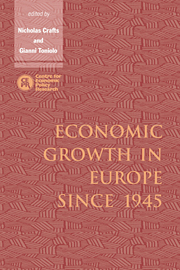Book contents
- Frontmatter
- Contents
- List of figures
- List of tables
- Preface
- List of contributors
- 1 Postwar growth: an overview
- 2 Institutions and economic growth: Europe after World War II
- 3 The varieties of Eurosclerosis: the rise and decline of nations since 1982
- 4 Why the 1950s and not the 1920s? Olsonian and non-Olsonian interpretations of two decades of German economic history
- 5 Convergence, competitiveness and the exchange rate
- 6 British economic growth since 1945: relative economic decline … and renaissance?
- 7 Economic growth in postwar Belgium
- 8 France, 1945–92
- 9 Economic growth and the Swedish model
- 10 Characteristics of economic growth in the Netherlands during the postwar period
- 11 Portuguese postwar growth: a global approach
- 12 Growth and macroeconomic performance in Spain, 1939–93
- 13 Irish economic growth, 1945–88
- 14 Italy
- 15 West German growth and institutions, 1945–90
- 16 An exercise in futility: East German economic growth and decline, 1945–89
- 17 Postwar growth of the Danish economy
- 18 Reflections on the country studies
- Index
3 - The varieties of Eurosclerosis: the rise and decline of nations since 1982
Published online by Cambridge University Press: 04 August 2010
- Frontmatter
- Contents
- List of figures
- List of tables
- Preface
- List of contributors
- 1 Postwar growth: an overview
- 2 Institutions and economic growth: Europe after World War II
- 3 The varieties of Eurosclerosis: the rise and decline of nations since 1982
- 4 Why the 1950s and not the 1920s? Olsonian and non-Olsonian interpretations of two decades of German economic history
- 5 Convergence, competitiveness and the exchange rate
- 6 British economic growth since 1945: relative economic decline … and renaissance?
- 7 Economic growth in postwar Belgium
- 8 France, 1945–92
- 9 Economic growth and the Swedish model
- 10 Characteristics of economic growth in the Netherlands during the postwar period
- 11 Portuguese postwar growth: a global approach
- 12 Growth and macroeconomic performance in Spain, 1939–93
- 13 Irish economic growth, 1945–88
- 14 Italy
- 15 West German growth and institutions, 1945–90
- 16 An exercise in futility: East German economic growth and decline, 1945–89
- 17 Postwar growth of the Danish economy
- 18 Reflections on the country studies
- Index
Summary
Introduction
Valuable as they are, conventional economic models have not succeeded in explaining the great differences in economic performance in different countries or historical periods. The ‘old’ growth theory is called into question by the absence of the convergence in per-capita income levels across the globe that it leads one to expect. The ‘new’ growth theory readily accommodates continuing differences in per-capita incomes across countries, but does not yet provide much insight into why the particular countries that became rich were the ones that grew. Neither does it explain why a few poor countries have led the world in economic growth at the same time that the poor countries as a whole have not been catching up.
In a book, The Rise and Decline of Nations, some article-length publications that foreshadowed it, and some subsequent papers and publications that focused on Eastern Europe and on the Third World, I presented a theory that combines the insights of familiar neoclassical economic models with a model of collective choice. The model of collective choice enables the theory to comprehend certain aspects of political and organizational life. The theory succeeds in explaining the most dramatic and puzzling variations in economic performance across countries. The present chapter will differ from the aforementioned book and articles in two ways.
First, this chapter will attempt to show how the same fundamental forces that influence economic performance everywhere show up in a very different forms in countries with different initial conditions.
- Type
- Chapter
- Information
- Economic Growth in Europe since 1945 , pp. 73 - 94Publisher: Cambridge University PressPrint publication year: 1996
- 12
- Cited by



